The document discusses various decision making and looping statements in C programming language. It describes if, if-else, nested if, switch statements for decision making. It also covers while, for, do-while and nested loops for looping/iteration. Examples are provided for each statement to illustrate their syntax and usage. Arrays, functions, recursion and passing arrays to functions are also mentioned as topics to be covered.
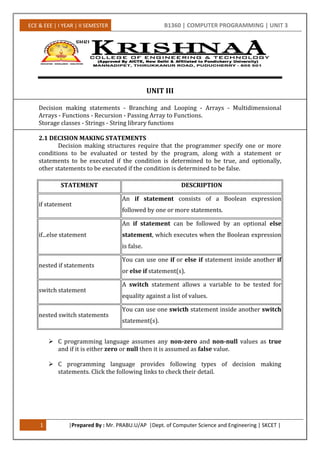
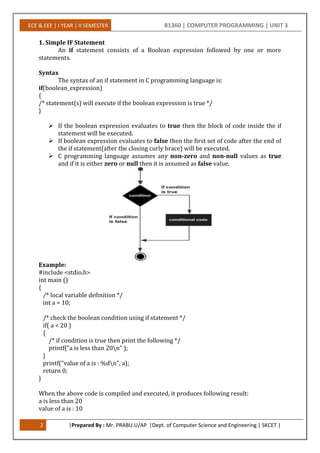
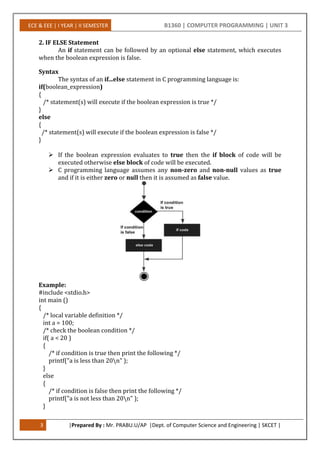
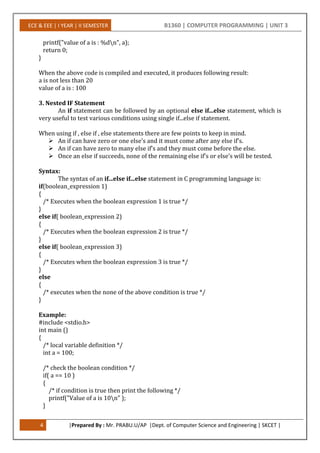


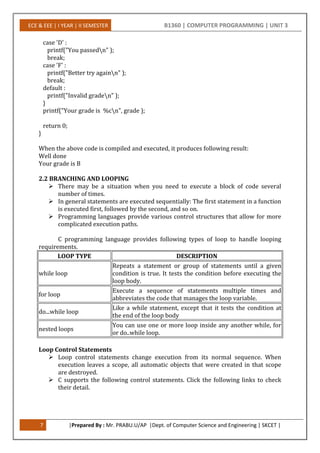



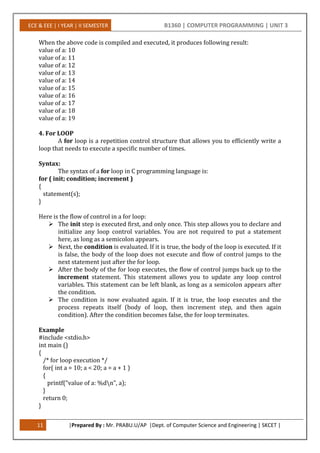

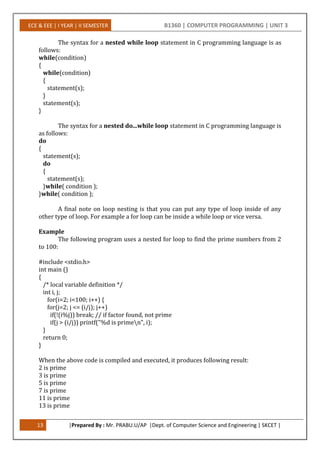

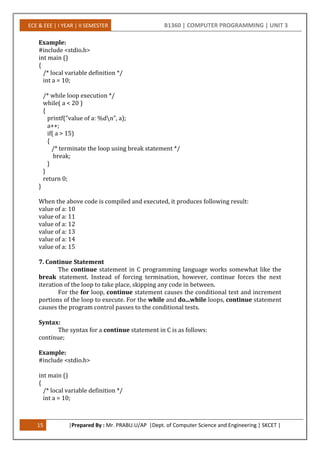


![ECE & EEE | I YEAR | II SEMESTER B1360 | COMPUTER PROGRAMMING | UNIT 3
18 |Prepared By : Mr. PRABU.U/AP |Dept. of Computer Science and Engineering | SKCET |
value of a: 14
value of a: 16
value of a: 17
value of a: 18
value of a: 19
2.3 ARRAYS
1. Defining And Processing Arrays
Many applications require the processing of multiple data items that have
common characteristics. In such a situation it is convenient to place such data item in
an Array
An array is a collection of similar data items that are stored under a common
name. A value in an array is identified by index or subscript enclosed in square brackets
with array name.
The individual data items can be integers, floating point numbers, and characters
and so on, but they must be the same type and same storage class.
Each array element is referred by specifying the array name with subscripts
each subscripts enclosed in square brackets and each subscript must be a non-negative
integer.
Thus ‘n’ elements array ‘A’ and the elements are
A[0],A[1],A[2]…..A[N-1]
The value of each subscript can be expressed as an integer constant or an integer
variable or an integer expression.
The arrays can be used to represent not only simple list of value but also task of
data items in two and three or more dimensions.
Arrays can be classified into
One-Dimensional arrays
Two-Dimensional arrays
Multi-Dimensional arrays
i) Array Declaration
Arrays are declared in the same manner as an ordinary variables except that
each array name must have the size of the array i.e., number of elements accommodate
in that array. Like variables, the array must be declared before they are used.
Syntax :
data_type array_variable [Size or Subscript of the array];
data type – Specifies the type of the data that will be contained in the array
array_variable- Specifies the name of the array
Size or Subscript – Specifies the maximum number of elements that the array
can hold
The subscript of an array can be integer constant, integer variable or an
expression that yields an integer value
Example: int a[5];
Where, ‘a’ is the name of the array with 5 subscripts of integer data types and
the computer reserves five storage location as shown below.](https://image.slidesharecdn.com/unit3-180313055425/85/Decision-Making-Statements-Arrays-Strings-18-320.jpg)
![ECE & EEE | I YEAR | II SEMESTER B1360 | COMPUTER PROGRAMMING | UNIT 3
19 |Prepared By : Mr. PRABU.U/AP |Dept. of Computer Science and Engineering | SKCET |
a
a[0]
a[1]
a[2]
a[3]
a[4]
ii) Processing an Array
The entire array cannot be accessed with single operation. So, the array elements
must be accessed on an element-by element basis.
This can be usually done with the help of the loop, when each pass of the loop is
used to access an array element, thus the number of passes through the loop will
therefore equal the number of array elements to be processed.
2. Array Initialisation
The values can be initialized to an array, when they are declared like ordinary
variable, otherwise they hold garbage values.
The array can be initialized in the following two ways:
i) At compile time
ii) At run time
i) At Compile Time
Syntax:
data_type array name [size]={List of values};
Where,
The list of values must be separated by commas.
Example:
int marks[3]={70,50,86};
This statement declares the variable marks as an array of 3 elements and will be
assigned to values specified in list as shown below
marks[0]
marks[1]
marks[2]
//Program to read marks using array initialization
#include<stdio.h>
void main()
{
int studmark[5]={99,97,87,89,92};int i;
printf(“mark of the student is:n”);
for(i=0;i<=4;++i)
{
printf(“%dt”,studmark[i]);
}
getch();
}
70
50
86](https://image.slidesharecdn.com/unit3-180313055425/85/Decision-Making-Statements-Arrays-Strings-19-320.jpg)
![ECE & EEE | I YEAR | II SEMESTER B1360 | COMPUTER PROGRAMMING | UNIT 3
20 |Prepared By : Mr. PRABU.U/AP |Dept. of Computer Science and Engineering | SKCET |
ii) At Run time
The array can be explicitly initialized at run time
Example :
int n[2];
scanf("%d%d",&n[0],&n[1]);
Like, the array can also be initialized by reading data items from the input
//Input n numbers and display n numbers
#include<stdio.h>
void main()
{
int a[100];
int i,n;
clrscr();
printf(“number of elements in arrayn”);
scanf(“%d”,&n);
printf(“enter the elementsn”);
for(i=0;i<n-1;++i)
{
scanf(“%d”,&a[i])
}
printf(“elements in arrayn”);
for(i=0;i<=n-1;++i)
{
printf(“%dt”,a[i]);
}
getch();
}
3. One-Dimensional Array
The collection of data items can be stored under a one variable name using only
one subscript, such a variable is the one-dimensional array.
//Add ten numbers and find sum and average
#include<stdio.h>
void main()
{
int i,num[10],sum=0; float avg=0.0;
printf(“enter ten numbers:n”);
for(i=0;i<10;i++)
{
scanf(“%”,&num[i]);
sum+=num[i];
}
avg=(float)sum/10.0;
printf(“n sum of 10 number is:%7.2d”,sum);
printf(“n average of 10 number is :%5.3f”,avg);
getch();
}](https://image.slidesharecdn.com/unit3-180313055425/85/Decision-Making-Statements-Arrays-Strings-20-320.jpg)
![ECE & EEE | I YEAR | II SEMESTER B1360 | COMPUTER PROGRAMMING | UNIT 3
21 |Prepared By : Mr. PRABU.U/AP |Dept. of Computer Science and Engineering | SKCET |
4. Two-Dimensional Array
Two dimensional arrays are used in situation where a table of values need to be
stored in an array.
These can be defined in the same fashion as in one dimensional arrays, except a
separate pair of square brackets are required for each subscript.
Two pairs of square brackets required for to dimensional array and three pairs
required for three dimensional arrays and so on.
Syntax: data_type array_name[row size] [column size];
data_type - specifies the type of the data that will be contained in the array.
array_name - specifies the name of the array
[row size] specifies the size of the row
[column size] specifies the size of the column
Example: int a[3][3];
Two dimensional arrays are stored in a row-column matrix, where the left index
indicates the row the right indicates the column.
Where 'a' is the array name and it reserves 3 row and 3 columns of memory as
shown below
i)Rules for Declaring Two-Dimensional Array
For matrix addition and subtraction
For matrix multiplication, first matrix column and second matrix must be equal.
/******* MATRIX ADDITION ****/
#include<stdio.h>
#include<conio.h>
void main()
{
int i,j,m,n;
int a[5][5],b[5][5],c[5][5];
clrscr();
printf("nttt MATRIX ADDITION nn");
printf("n Enter the Order of Matrix: n");
scanf("%d%d",&m,&n);
printf("nEnter the Elements of 1st Matris:n");
for(i=0;i<m;i++)
{
for(j=0;j<n;j++)
{
scanf("%d",&a[i][j]);
}
printf("n");
}
printf("n Enter the Elements of 2nd Matrix: n");
for(i=0;i<m;i++)
{
for(j=0;j<n;j++)](https://image.slidesharecdn.com/unit3-180313055425/85/Decision-Making-Statements-Arrays-Strings-21-320.jpg)
![ECE & EEE | I YEAR | II SEMESTER B1360 | COMPUTER PROGRAMMING | UNIT 3
22 |Prepared By : Mr. PRABU.U/AP |Dept. of Computer Science and Engineering | SKCET |
{
scanf("%d",&b[i][j]);
}
printf("n");
}
printf("n The Resultant Matrix is: n");
for(i=0;i<m;i++)
{
for(j=0;j<n;j++)
{
c[i][j]=a[i][j]+b[i][j];
printf("%dt",&c[i][j]);
}
printf("nn");
}
getch();
}
ii) Initializing an Two-Dimensional Array.
A Two-Dimensional Array can be also initialized. For that the array values are
specified within a Compound statement. (i.e.,) { and }.
General form :-
Storage-class data-type array-name[r][c] = { value1, value2, .. .. .. , value n};
Here storage class may be static or extern by default. Storage-class is optional.
Data-type refers to a valid C data type.
Array-name refers to a valid array name.
Here r stands for number of rows and c stands for number of columns.
Each values in an array are separated by commas and terminated by semicolon.
#include<stdio.h>
void main()
{
int i,j;
float a[4][2]={{12.3,34,5},{23.4,45.6},{34.5,56.7},{45.6,67.8}};
printf(“Element value Address”);
for(i=0;i<4;i++)
{
for(j=0;j<2;j++)
{
printf(“n a[%d] [%d] %0.2f %p”,i,j,a[i][j],&a[i][j]);
}
}
getch();
}](https://image.slidesharecdn.com/unit3-180313055425/85/Decision-Making-Statements-Arrays-Strings-22-320.jpg)
![ECE & EEE | I YEAR | II SEMESTER B1360 | COMPUTER PROGRAMMING | UNIT 3
23 |Prepared By : Mr. PRABU.U/AP |Dept. of Computer Science and Engineering | SKCET |
5. Multi-Dimensional Array
Multi-dimensional Array consists of (or) requires more than two square brackets
and it may contain any number of values specified within square brackets. It may be
three, four, five, six and so on.
A Multi dimensional Array in general takes the following form.
General form :-
Storage-class data-type array-name[s1][s2]……………[sn];
Here storage class may be static or extern by default. Here Storage-class is optional.
Data-type refers to a valid C data type. Array-name refers to a valid array name. s1,s2,s3,
……… are sub scripts.
SORTING AN ARRAY
Sorting is the process of Arranging the set of data items in an order. Sorting may
be carried out in Ascending or Descending order. Sorting helps to increase the efficiency
of a program.
//Sort number in ascending order
#include<stdio.h>
void main()
{
int i,j,k,num[5],temp;
clrscr();
printf(“Enter five numbers:n”);
for(i=0;i<5;i++)
{
scanf(“%d”,&num[i]);
}
printf(“n THE ORIGINAL LIST IS:n”);
for(i=0;i<5;i++)
printf(“%dt”,num[i]);
for(i=0;i<4;i++)
for(j=i+1;j<5;j++)
{
if num[i]>num[j]
{
temp=num[i];
num[i]=num[j];
num[j]=temp;
}
printf(“n the sorted numbers are:n”);
for(i=0;i<5;i++)
printf(“%dt”,num[i]);
getch();
}
Features of Arrays :
An array is a derived data type. It is used to represent a collection of elements of
the same data type.](https://image.slidesharecdn.com/unit3-180313055425/85/Decision-Making-Statements-Arrays-Strings-23-320.jpg)





![ECE & EEE | I YEAR | II SEMESTER B1360 | COMPUTER PROGRAMMING | UNIT 3
29 |Prepared By : Mr. PRABU.U/AP |Dept. of Computer Science and Engineering | SKCET |
2.5 RECURSION
Recursion is the process of calling the same function itself again and again until
some condition is satisfied. This process is used for repetitive computation in which
each action is satisfied in terms of a previous result.
Example:
#include <stdio.h>
int factorial(unsigned int i)
{
if(i <= 1)
{
return 1;
}
return i * factorial(i - 1);
}
int main()
{
int i = 15;
printf("Factorial of %d is %dn", i, factorial(i));
return 0;
}
When the above code is compiled and executed, it produces the following result:
Factorial of 15 is 2004310016
2.6 PASSING ARRAYS TO FUNCTIONS
If you want to pass a single-dimension array as an argument in a function, you
would have to declare function formal parameter in one of following three ways and all
three declaration methods produce similar results because each tells the compiler that
an integer pointer is going to be received. Similar way you can pass multi-dimensional
array as formal parameters.
Way-1
Formal parameters as a pointer as follows. You will study what is pointer in next
chapter.
void myFunction(int *param)
{
.
.
.
}
Way-2
Formal parameters as a sized array as follows:
void myFunction(int param[10])
{
.
.
.
}](https://image.slidesharecdn.com/unit3-180313055425/85/Decision-Making-Statements-Arrays-Strings-29-320.jpg)
![ECE & EEE | I YEAR | II SEMESTER B1360 | COMPUTER PROGRAMMING | UNIT 3
30 |Prepared By : Mr. PRABU.U/AP |Dept. of Computer Science and Engineering | SKCET |
Way-3
Formal parameters as an unsized array as follows:
void myFunction(int param[])
{
.
.
.
}
Example
Now consider the following function which will take an array as an argument
along with another argument and based on the passed arguments, it will return average
of the numbers passed through the array as follows:
double getAverage(int arr[], int size)
{
int i;
double avg;
double sum;
for (i = 0; i < size; ++i)
{
sum += arr[i];
}
avg = sum / size;
return avg;
}
Now let us call the above function as follows:
#include <stdio.h>
/* function declaration */
double getAverage(int arr[], int size);
int main ()
{
/* an int array with 5 elements */
int balance[5] = {1000, 2, 3, 17, 50};
double avg;
/* pass pointer to the array as an argument */
avg = getAverage( balance, 5 ) ;
/* output the returned value */
printf( "Average value is: %f ", avg );
return 0;
}
When the above code is compiled together and executed, it produces following result:
Average value is: 214.400000
As you can see, the length of the array doesn't matter as far as the function is concerned
because C performs no bounds checking for the formal parameters.](https://image.slidesharecdn.com/unit3-180313055425/85/Decision-Making-Statements-Arrays-Strings-30-320.jpg)





![ECE & EEE | I YEAR | II SEMESTER B1360 | COMPUTER PROGRAMMING | UNIT 3
36 |Prepared By : Mr. PRABU.U/AP |Dept. of Computer Science and Engineering | SKCET |
2.8 STRINGS
1.String Manipulation
In 'C' language the group of character, digits and symbols enclosed within
quotation marks are called as string otherwise string are array of characters. Null
character('/0') is used to mark the end of the string.
Example: char name[]={'S','T','R','I','N','G','/0'}
Each character is stored in one byte of memory and successive characters of the string
are stored in successive byte
2. Reading and Writing String
The '%s' control string can be used in scanf() statement to read a string from the
terminal and the same may be used to write string to the terminal in printf() statement.
Example: char name[10];
scanf("%s",name);
printf("%s",name);
** there is no address (&) operator used in scanf() statement
3. Character Array
Character Array is specified within single quotes and ended with semicolon. It is
used to define a single character for the array.
// Input 10 characters and print 10 characters
#include<stdio.h>
void main()
{
char character[10];
int cnt;
clrscr();
/*read character one by one*/
printf(“enter 10 charactern”);
for(cnt=0;cnt<10;cnt++)
character[cnt]=getchar();
/*display character one by one*/
printf(“nentered characters are :n”);
for(cnt=0;cnt<10;cnt++)
putchar(character[cnt]);
}
4. Strings Standard Function
The commonly used string manipulation functions are follows
1. The strlen() function
This function is used to count and return the number of character present in a
string
Syntax: var =strlen(string);
where, var - Is the integer variable, which accepts the length of the string
string - Is the string constant or string variable in which the length is going to be
found](https://image.slidesharecdn.com/unit3-180313055425/85/Decision-Making-Statements-Arrays-Strings-36-320.jpg)
![ECE & EEE | I YEAR | II SEMESTER B1360 | COMPUTER PROGRAMMING | UNIT 3
37 |Prepared By : Mr. PRABU.U/AP |Dept. of Computer Science and Engineering | SKCET |
Example: Program using strlen() function
#include<stdio.h>
#include<string.h>
main()
{
char name[100];
int length;
printf(“Enter the string”);
gets(name);
length=strlen(name);
printf(“nNumber of characters in the string is=%d”,length);
}
2. The strcpy() function
This function is used to copy the contents of one string to another and it almost
works like string assignment operator.
Syntax: strcpy(string1,string2);
string1 is the destination string
string2 is the source string
i.e., The contents of string2 is assigned to the contents of string1. where string2 may be
character array variable or string constant.
Example: Program using strcpy() function
#include<stdio.h>
#include<string.h>
main()
{
char source = “Welcome”;
char target[10];
strcpy(target,source);
printf(“n Source string is %s”,source);
printf(“n Target string is %s”,target);
}
3.The strcat() function
The strcat() function is used to concatenate or combine, two strings together and
forms a new concatenated string.
Syntax : strcat(string1,string2);
where, string1 and string2 are character type arrays or string constants. When
the above strcat function is executed, string2 is combined with string1 and it removes
the null character(/0) of string1 and places string2.](https://image.slidesharecdn.com/unit3-180313055425/85/Decision-Making-Statements-Arrays-Strings-37-320.jpg)
![ECE & EEE | I YEAR | II SEMESTER B1360 | COMPUTER PROGRAMMING | UNIT 3
38 |Prepared By : Mr. PRABU.U/AP |Dept. of Computer Science and Engineering | SKCET |
Example: Program using strcat() function
#include<stdio.h>
#include<string.h>
main()
{
char source[10]=”Ramesh”;
char target[10]=”Babu”;
strcat(source,target);
printf(“n Source string is %s”,source);
printf(n Target string is %s”,target);
}
OUTPUT
Source string is RameshBabu
Target string is Babu
4. The strcmp() function
This is a function which compares two strings to find out whether they are same
or different. The two strings are comparedcharacter by character until the end of one
of the string is reached. If the two strings are identical strcmp() returns a value zero. If
they are not equal, it returns the numeric difference between the first non-matching
characters
Syntax: strcmp(string1,string2);
string1 and string2 are character type arrays or string constants
Example: Program using strcmp() function
#include<stdio.h>
#include<string.h>
main()
{
char s1[20],s2[20];
int x;
printf(“Enter the strings”);
scanf(“%s%s”,s1,s2);
x=strcmp(s1,s2);
if(x!=0)
{
printf(“nStrings are not equaln”);
else
printf(“nStrings are equal”);
}
}
5. The strrev() function
The strrev function is used to reverse a string. This function takes only one
argument and return one argument. The general form of strrev() function is
Syntax: strrev(string);
string are characters type arrays ofr string constants](https://image.slidesharecdn.com/unit3-180313055425/85/Decision-Making-Statements-Arrays-Strings-38-320.jpg)
![ECE & EEE | I YEAR | II SEMESTER B1360 | COMPUTER PROGRAMMING | UNIT 3
39 |Prepared By : Mr. PRABU.U/AP |Dept. of Computer Science and Engineering | SKCET |
Example: Program using strrev() function
#include<stdio.h>
#include<string.h>
main()
{
char a[30];
printf(“Enter the string:”);
gets(a);
printf(“The string reversed is : %s”, strrev(a));
}
OUTPUT
Enter the string : array
The string reversed is : yarra
2.9 STRING LIBRARY FUNCTIONS
The header file related to string functions is <string.h>
FUNCTIONS MEANING
strcmp(s1,s2) Compares two strings. Return negative value if s1<s2. 0 if s1 and s2
are identical. Return positive value if s1>s2.
strcpy(s1,s2) Copies a string s2 to another string s1.
strcat(s1,s2) Combines the string s1 at the end of string s2.
strchr(s1,c) Finds first occurrence of a given character in a string. Compare
characters of string s1 with character starting from head of string s1.
strlen(s) Find length of a string s.
strlwr(s) Converts string s to lowercase
strrev(s) Reverse the string s.
strupr(s) Converts the string s to uppercase
strdup(s) Duplicate string s.
strncpy(s1,s2,n) Copies portion of string s2 to string s1 upto position n.
strncmp(s1,s2,n) Compares portion of string s2 to string s1 upto position n.
strrchr() Find last occurrence of a given character in a string.
strstr() Find first occurrence of a given string in another string.
strcmpi() Compares two strings without regard to case (“i” denotes that this
function ignores case ).](https://image.slidesharecdn.com/unit3-180313055425/85/Decision-Making-Statements-Arrays-Strings-39-320.jpg)